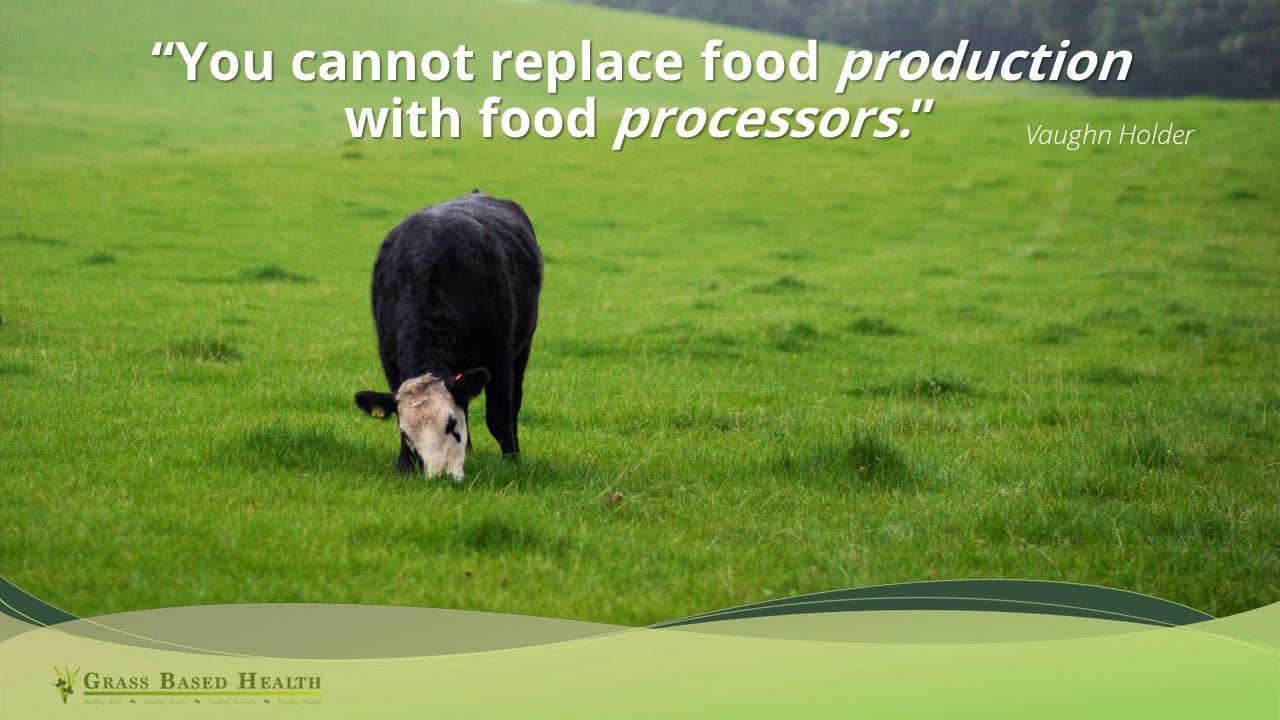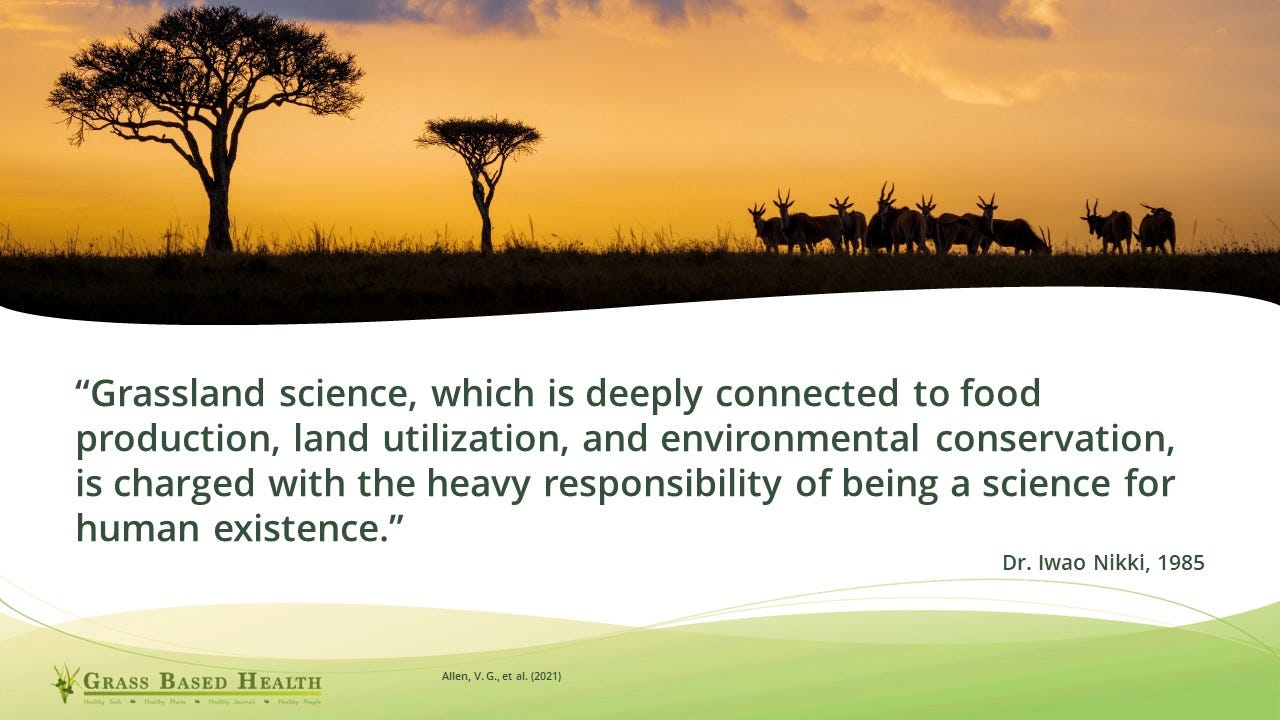This is the fifth installment, based upon my presentation “Human Flourishing: Integrated Livestock Cropping Systems’ Goal” at the IV International Symposium on Integrated Cropping-livestock Systems, November 7, 2023 in Bento Gonçalves, Brazil. Links to installments one, two, three, and four.
It is a critical point that you cannot replace food production with food processors (thank you, Dr. Holder). The wondrous ruminant animals take biomass that we can't utilize directly and they produce food for human use that’s of highest nutritional quality. In addition, they perform ecosystem services, social benefits, and provide numerous byproducts. If ruminants did not exist, they'd have to be invented! They’re solar powered, self-loading, self-replicating, anaerobic fermentation vessels.
When we process cereals, pulses or nuts, we're taking biomass that's already human edible and converting it into another form that's human edible. No new food is created. Since no industrial process is 100% efficient, the food supply is actually reduced. Compare this to when we feed maize (corn) grain to commercial steers, as practiced in the United States. Two hundred and forty percent more human-utilizable lysine is provided in the beef than was in the corn. It is a net protein contributor to the food supply. Of course, if we consider strictly grass-fed systems this contribution is literally incalculable since you can't divide by zero.
“Grassland science which is deeply connected to food production, land utilization, environmental conservation, is charged with the heavy responsibility of being a science for human existence.”1
This is the field, so to speak, in which I was trained. This is the perspective that I bring into the subject of Integrated Cropping-Livestock Systems and human flourishing. I want to focus on this word "food." It has many meanings, especially in today’s public and popular conversations. Is plant-source food equivalent to animal-source food? Are these foods equally essential? Do they have the same metabolic effect on the human beings fed them? If I have a pound of protein from animal source food and a pound of protein from plant source food, do they have the same effects on people being fed them? If not, why would we model food systems as if they do?
I’m arguing that we are operating under several fundamental misunderstandings and misconceptions. We must confront these, in part for our own personal benefit, but also for the benefit of those we serve through our research and demonstration efforts.
Here's a quiz. Which group of mammals is designed to digest a low-fat diet?
Group A contains sheep, cattle, and a mountain gorilla.
Group B contains modern Homo sapiens, lions, and polar bears.
Do you think Group A is the group that's designed to digest a low-fat diet or do you think it's Group B? Or do you suspect that it’s a trick question? If so, you’re right!
There's a difference between “digest” and “ingest.” Group A clearly INGESTS a low-fat diet. A mature cow’s diet contains, at most, six percent ether extract (or crude fat) on a dry matter basis.2 The microorganisms in her rumen break down the fiber and produce volatile fatty acids which she then absorbs. Seventy to eighty percent of her dietary energy is provided by those volatile fatty acids.
The cow INGESTS a low-fat diet, she DIGESTS a high-fat diet.
Humans don't have rumens. Humans evolved utilizing the ruminants which are the critical link in energy and nutrient flows within ecosystems, especially grasslands.3
Many essential nutrients are solely or best-provided by animals-source foods in humanity’s diet.4 Ruminant animal agriculture offers key ecological advantages and benefits over other forms of animal agriculture.5
Another idea: You are NOT what you eat. You are what your body does with what you eat.
Here’s an example - The hay in front of those cows is high in fiber, low in fat, and low in protein content and quality (from a human nutrition perspective). Yet the milk they produce, and their muscles and organs are just the opposite!
Other examples: The more saturated fat you eat, the lower the amount of saturated fatty acids in your blood;6 The more cholesterol you eat, the less cholesterol your body makes (and vice versa).7
Las one: Do you think if we put a Basset on a treadmill, we'll turn it into a Greyhound?
Those of us who are born as Bassets are kind of tired of being lectured to by the Greyhound people who were born naturally thin and think it's because they exercise 16 times a week and deny themselves in various ways.
I have three essential keys that guide me in my thoughts and efforts:
Public health will be harmed by too little animal source foods.
Animal agriculture in general, and ruminant animals in particular, are essential for sustainable food systems.
Animal source foods are part of culture and traditions, regardless of where they originated.
Final installment tomorrow - Humanity’s diet is already plant-based (and maybe THAT’S the problem)
Allen, V.G., Wilkins, R.J.L., G. D., Smith, S.R., 2021. The History of the International Grassland Congress - 1927 to 2020. The Forage and Grassland Foundation, Lexington, KY, USA,.
Van Soest, P.J., 1994. Nutritional ecology of the ruminant, 2nd ed. Comstock Pub., Ithaca.
See Thompson, J.C., Carvalho, S., Marean, C.W., Alemseged, Z., 2019. Origins of the Human Predatory Pattern: The Transition to Large-Animal Exploitation by Early Hominins. Current Anthropology. 60(1), 1-23. https://doi.org/10.1086/701477 and her YouTube presentation “Fat of the land: What ancient bones tell us about the origin of the human diet”
Murphy, S.P., Allen, L.H., 2003. Nutritional importance of animal source foods. The Journal of nutrition. 133(11), 3932S-3935S. https://doi.org/10.1016/j.tjnut.2023.08.032.
Collins, M., Nelson, C.J., Moore, K.J., Barnes, R.F., 2017. Forages, volume 1: an introduction to grassland agriculture. John Wiley & Sons.
Moore, K.J., Collins, M., Nelson, C.J., Redfearn, D.D., 2020. Forages, Volume 2: The science of grassland agriculture. John Wiley & Sons.
Volk, B.M., Kunces, L.J., Freidenreich, D.J., Kupchak, B.R., Saenz, C., Artistizabal, J.C., Fernandez, M.L., Bruno, R.S., Maresh, C.M., Kraemer, W.J., Phinney, S.D., Volek, J.S., 2014. Effects of step-wise increases in dietary carbohydrate on circulating saturated fatty acids and palmitoleic acid in adults with metabolic syndrome. PLoS ONE. 9. https://doi.org/10.1371/journal.pone.0113605.
See, for example, Nestel, P.J., Poyser, A., 1976. Changes in cholesterol synthesis and excretion when cholesterol intake is increased. Metabolism. 25(12), 1591-1599. https://doi.org/10.1016/0026-0495(76)90112-8.










